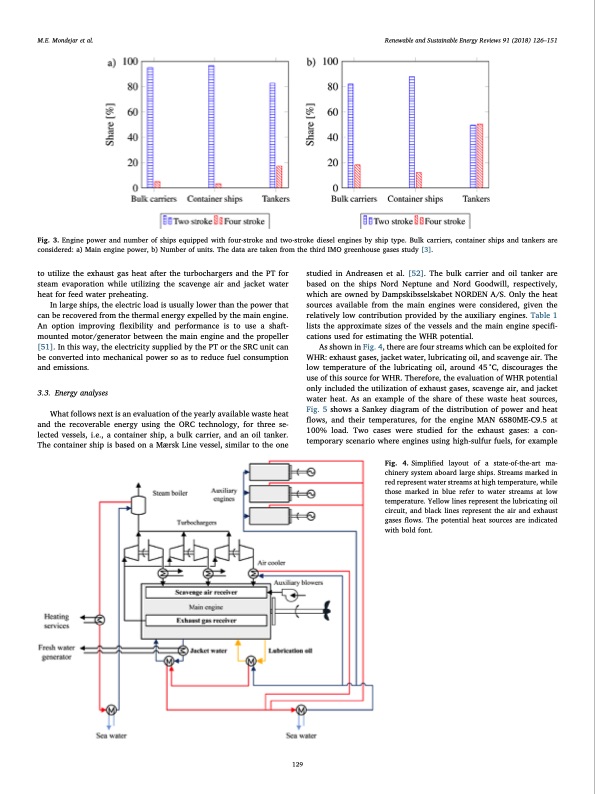
PDF Publication Title:
Text from PDF Page: 005
M.E. Mondejar et al. Renewable and Sustainable Energy Reviews 91 (2018) 126–151 Fig. 3. Engine power and number of ships equipped with four-stroke and two-stroke diesel engines by ship type. Bulk carriers, container ships and tankers are considered: a) Main engine power, b) Number of units. The data are taken from the third IMO greenhouse gases study [3]. to utilize the exhaust gas heat after the turbochargers and the PT for steam evaporation while utilizing the scavenge air and jacket water heat for feed water preheating. In large ships, the electric load is usually lower than the power that can be recovered from the thermal energy expelled by the main engine. An option improving flexibility and performance is to use a shaft- mounted motor/generator between the main engine and the propeller [51]. In this way, the electricity supplied by the PT or the SRC unit can be converted into mechanical power so as to reduce fuel consumption and emissions. 3.3. Energy analyses What follows next is an evaluation of the yearly available waste heat and the recoverable energy using the ORC technology, for three se- lected vessels, i.e., a container ship, a bulk carrier, and an oil tanker. The container ship is based on a Mærsk Line vessel, similar to the one studied in Andreasen et al. [52]. The bulk carrier and oil tanker are based on the ships Nord Neptune and Nord Goodwill, respectively, which are owned by Dampskibsselskabet NORDEN A/S. Only the heat sources available from the main engines were considered, given the relatively low contribution provided by the auxiliary engines. Table 1 lists the approximate sizes of the vessels and the main engine specifi- cations used for estimating the WHR potential. As shown in Fig. 4, there are four streams which can be exploited for WHR: exhaust gases, jacket water, lubricating oil, and scavenge air. The low temperature of the lubricating oil, around 45 °C, discourages the use of this source for WHR. Therefore, the evaluation of WHR potential only included the utilization of exhaust gases, scavenge air, and jacket water heat. As an example of the share of these waste heat sources, Fig. 5 shows a Sankey diagram of the distribution of power and heat flows, and their temperatures, for the engine MAN 6S80ME-C9.5 at 100% load. Two cases were studied for the exhaust gases: a con- temporary scenario where engines using high-sulfur fuels, for example Fig. 4. Simplified layout of a state-of-the-art ma- chinery system aboard large ships. Streams marked in red represent water streams at high temperature, while those marked in blue refer to water streams at low temperature. Yellow lines represent the lubricating oil circuit, and black lines represent the air and exhaust gases flows. The potential heat sources are indicated with bold font. 129PDF Image | organic Rankine cycle power systems for maritime applications

PDF Search Title:
organic Rankine cycle power systems for maritime applicationsOriginal File Name Searched:
1_s20_S136403211830162X_main.pdfDIY PDF Search: Google It | Yahoo | Bing
NFT (Non Fungible Token): Buy our tech, design, development or system NFT and become part of our tech NFT network... More Info
IT XR Project Redstone NFT Available for Sale: NFT for high tech turbine design with one part 3D printed counter-rotating energy turbine. Be part of the future with this NFT. Can be bought and sold but only one design NFT exists. Royalties go to the developer (Infinity) to keep enhancing design and applications... More Info
Infinity Turbine IT XR Project Redstone Design: NFT for sale... NFT for high tech turbine design with one part 3D printed counter-rotating energy turbine. Includes all rights to this turbine design, including license for Fluid Handling Block I and II for the turbine assembly and housing. The NFT includes the blueprints (cad/cam), revenue streams, and all future development of the IT XR Project Redstone... More Info
Infinity Turbine ROT Radial Outflow Turbine 24 Design and Worldwide Rights: NFT for sale... NFT for the ROT 24 energy turbine. Be part of the future with this NFT. This design can be bought and sold but only one design NFT exists. You may manufacture the unit, or get the revenues from its sale from Infinity Turbine. Royalties go to the developer (Infinity) to keep enhancing design and applications... More Info
Infinity Supercritical CO2 10 Liter Extractor Design and Worldwide Rights: The Infinity Supercritical 10L CO2 extractor is for botanical oil extraction, which is rich in terpenes and can produce shelf ready full spectrum oil. With over 5 years of development, this industry leader mature extractor machine has been sold since 2015 and is part of many profitable businesses. The process can also be used for electrowinning, e-waste recycling, and lithium battery recycling, gold mining electronic wastes, precious metals. CO2 can also be used in a reverse fuel cell with nafion to make a gas-to-liquids fuel, such as methanol, ethanol and butanol or ethylene. Supercritical CO2 has also been used for treating nafion to make it more effective catalyst. This NFT is for the purchase of worldwide rights which includes the design. More Info
NFT (Non Fungible Token): Buy our tech, design, development or system NFT and become part of our tech NFT network... More Info
Infinity Turbine Products: Special for this month, any plans are $10,000 for complete Cad/Cam blueprints. License is for one build. Try before you buy a production license. May pay by Bitcoin or other Crypto. Products Page... More Info
| CONTACT TEL: 608-238-6001 Email: greg@infinityturbine.com | RSS | AMP |